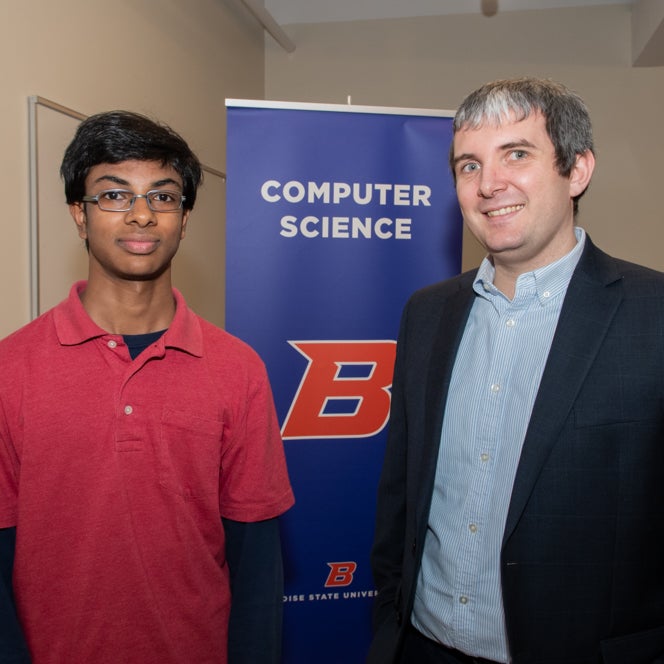
Boise High School student Jayanth Mouli had been recognized as a top 300 scholar in the 2020 Regeneron Science Talent Search. The Regeneron Science Talent Search (Regeneron STS), a program of Society for Science and the Public, is the nation’s most prestigious science and math competition for high school seniors.
Mouli was mentored by Boise State computer science professor Edoardo Serra, and was awarded for research about the use of modern artificial intelligence (AI) techniques to predict a wildfire’s growth over time.
The title of the research Mouli presented is “Predictive Modeling of Wildfire Shape Using Long Short-Term Memory Convolutional Neural Networks.”
“He came to me saying ‘I want to solve this problem’ and he was so firm and so sure about it,” said Serra.”[Jayanth is] tremendously autonomous, proactive and a self-learner. I gave him preliminary ideas on how to approach that problem and he was able to materialize them autonomously: really an amazing experience for me.”
Q and A with Mouli
Q: What is your research and the goal of your work?
Mouli: “Due to climate change, wildfires around the world have increased in frequency and intensity. The ability to predict the burned area of wildfires can minimize the destructive impact of wildfires on communities, and reduce firefighting expenditures. My research aims to use modern Artificial Intelligence (AI) techniques to predict a wildfire’s growth over time. By analyzing satellite imagery from NASA and historical weather data, I was able to derive information about vegetation, topography, wind speed and other factors that influence fire growth.
I used this information to train an artificial neural network, which was able to identify past trends in wildfire progression to predict future positions. This neural network architecture was able to successfully determine the “shape” of several past wildfires in Northern California. The results of my research showed that deep learning techniques can be adapted to model the spatially spreading systems that are so abundant in nature.”
Q: What made you decide to pursue this research?
M: “My interest in wildfires was born when I encountered one firsthand during a backpacking trip with the Boy Scouts. The way the fire grew was especially interesting, as it resembled the temporal growth that can be seen in so many other natural processes. I had become fascinated by the applications of AI in real-world problems, from classifying images to predicting tumor growth. I realized that a wildfire’s motion was influenced by several quantifiable factors, and there was potential in the use of AI techniques to solve this problem.”
Q: How did you meet Professor Serra?
M: “After working on my project for several months, I wanted to get the input of a professor who could verify my approach. I found that professor Serra had similar research interests to me. One day after school, I walked from Boise High to the downtown Boise State computer science building to meet Dr. Serra. Since then, I have frequently gained valuable input about different AI techniques and data processing methods from Dr. Serra.”
Q: When you graduate from high school, what are your plans? Do you plan to continue doing research?
M: “I plan on studying electrical engineering and computer science in college. I am not sure which field I prefer – I am interested in both the physics of electricity and magnetism, as well as the logical thinking required in computer science. By studying both fields, I hope to build a solid foundation from which I can narrow down my interests in the future. I also plan on pursuing research as an undergraduate next year. I hope the availability of resources in college will enable me to pursue impactful projects, as well as eliminate some of the obstacles I faced while conducting research as a high schooler.”
Q: Who inspires you?
M: “I have a poster in my room (where I usually worked on my project) that depicts a man running up a flight of stairs on a hot summer’s day. The caption reads, ‘Perseverance: the difference between a successful person and others is not a lack of strength, not a lack of knowledge, but rather a lack of will.” When I encountered an obstacle in my project, a quick look at this poster motivated me to tackle these obstacles with confidence. Although I have never met this man on the poster, he was the biggest inspiration and motivation for me throughout my project.”
Q: Are there any teachers who have made a big impression on you?
M: “I would largely credit my interest in scientific research to my time studying at the Treasure Valley Mathematics and Science Center (TVMSC) from sixth to ninth grade. At TVMSC, I had the opportunity to compete in the National Science Bowl – a buzzer-based math and science quiz competition. As the questions were from a wide variety of subjects, I became interested in finding connections between different fields, like environmental science and mathematics. The STEM activities I pursued at this school largely contributed to my fascination with scientific research.”
– Interview by Brianne Philips